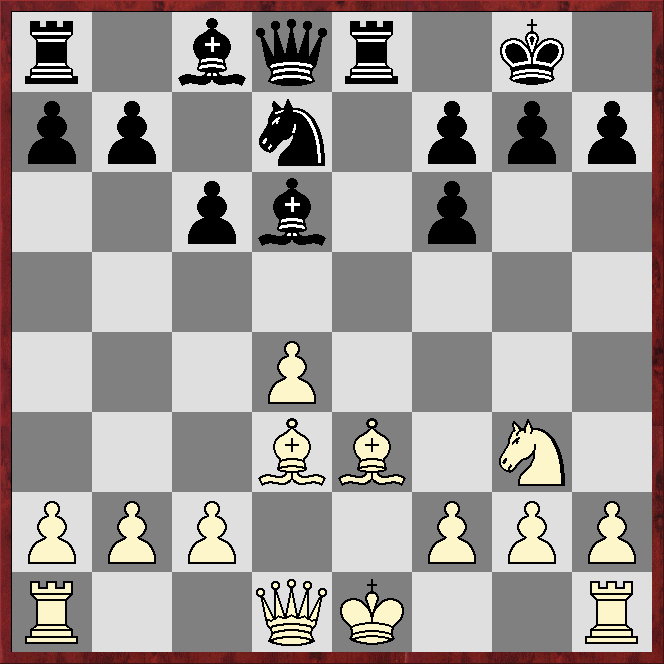TWO proverbs that come to my mind quite often are, "Worse things happen at sea," and "There's always someone worse off."
The latter in particular was brought home to me by the drama that unfolded in the last two rounds of the British 65+ championship at Leicester.
Favourite in the 52-player event was Fide master Terry Chapman, whose 2248 rating put him more than 100 elo ahead of everyone else.
I was not paying much attention to his games, but he was a point clear of the field when he reached five out of five, a score that included a round-five win against his nearest rival in rating terms, Scottish Fide master Philip Giulian (2141).
Then came round six.
Alan Punnett (2051) - Terry Chapman (FM 2248)
Caro-Kann Tartakower
1.e4 c6 2.d4 d5 3.Nc3 dxe4 4.Nxe4 Nf6 5.Nxf6+ exf6!?
This, arguably anti-positional, recapture is all the rage although it dates back in master play to at least 1898.
6.Be3 Bd6 7.Bd3 Nd7 8.Ne2 0-0
German grandmaster Vincent Keymer has twice played 8...f5!?, which is also the choice of Stockfish16 and Komodo14.1.
9.Ng3 Re8
*****
*****
*****
*****
To a certain extent the pawn-structure dictates the players' overall strategies.
White's potential queenside passer makes most endgames an attractive proposition, so it is often natural to seek exchanges.
Black's play is perhaps a little more subtle. If both sides castle short, which they usually do, Black's king will have more pawns protecting it. Furthermore Black may be better placed to push pawns on the kingside, possibly as part of a pawn-storm or, at least initially, to drop the knight in on e4 (after playing ...f5).
I presume it was such general considerations that led AP in this game to play ...
10.Nf5!?
... but it is a move the engines are not keen on. They suggest 10.0-0, 10.c3 or 10.Qd2.
10...Nf8?!
This gives up the bishop-pair. Not only that, but the dark-square bishop is often Black's most potent piece in the early going of the Tartakower Variation.
After 10...Bc7 the white knight will get hit by ...g6, eg 11.0-0 g6 12.Ng3 (12.Nh6+ Kg7 favours Black, according to the engines) f5 13.Qd2 Nf6 with what seems a perfectly reasonable position. The engines reckon 11.Qg4 is nothing to worry about after 11...g6 12.Nh6+ Kf8, with the threat of ...Ne5 or ...Nc5 to come.
11.Nxd6 Qxd6
TC may have thought the four tempi spent by the knight in going from g1 to e2 to g3 and f5, and then exchanging itself in a way that lets Black recapture with a developing move, is too high a price for White to pay, but the engines disagree.
12.0-0 a5 13.c4 Be6 14.Qc2 Red8 15.Rfd1 Qc7 16.Rac1 g6
*****
*****
*****
*****
We are a long way from any ending, and White's bishop-pair is not (yet) a dominant force. On the other hand there is no sign of a Black kingside attack, and is not clear any such attack would be effective, even if it came, as Black's pieces are not well-coordinated for such action and Black will miss his dark-square bishop. Meanwhile White has more space in the centre and the better pawn-structure. The engines reckon White has a positionally won game.
17.Qe2 Qe7 18.Qf3 h5 19.h3 Rd6?
17.Qe2 Qe7 18.Qf3 h5 19.h3 Rd6?
This loses the exchange. The engines suggest 19...a4 or 19...Nh7, but have White on top.
20.d5 cxd5 21.Bc5 Rad8?!
The engines prefer 21...dxc4 22.Bxd6 Qxd6, although 23.Bxg6 Qe5 24.Bxh5 leaves White the exchange up and with much the safer king.
22.Bxd6?!
Much stronger is 22.cxd5 Bxd5 23.Qxd5 Rxd5 24.Bxe7, winning a piece.
22...Rxd6 23.Re1 d4
 |
| Black has a passed pawn for the exchange - if he had the bishop-pair as well, he might be in business |
*****
*****
*****
*****
24.Be4 Rb6?!
Almost certainly better is 24...Rd7, keeping an eye on d4 as well as protecting b7.
25.b3 Nd7 26.Qd3 Qa3?!
Exchanging pawn captures on d4 and a2 is probably not a good deal, especially as the fall of the d4 pawn exposes the f6 one.
27.Qxd4 Qxa2 28.Bd5 Rd6 29.Qc3 Nc5!?
Not much of an improvement, if any at all, is the engines' 29...Qa3 30.Bxe6 fxe6 31.c5 Rc6 32.Qd4 Ne5 33.Qd8+ Kg7 34.b4!? Nf7 35.Qd7 axb4 36.Qxb7, after which White's passed pawn is the more dangerous.
30.Bxe6 Rxe6 31.Rxe6 Nxe6 32.Ra1 Qe2 33.Qxf6 Qd2 34.Qe5 b6 35.Qb8+
*****
*****
*****
*****
The game saw:
35...Qd8 36.Qxd8+ Nxd8 37.Rd1 (1-0, 49 moves).
Of course anyone can lose to a player rated about 200 points lower, as a cursory look at almost any open tournament will show.
The Calamity in my title refers not to the game above. but to what happened the next day in the seventh and final round.
On top board Punnett had black against Sheila Jackson. Both were on five points, were roughly equally rated and duly drew.
Chapman was downfloated with white against David Fryer, who was enjoying a very good tournament, having gained 36.6 elo, but whose 1880 rating was unlikely to have a Fide master quaking in his boots.
The round started at 10:00, but the default time of 30 minutes had elapsed by eight minutes, an arbiter told me later, when Chapman arrived.
Apparently his watch had stopped, and by the time he noticed the correct time it was too late.
The result was the 2023 65+ championship was shared by the other three players mentioned above, all of whom ended on 5.5.



Hansen suggests 6....Na6 and if 7. Bxa6 then Qa5+
ReplyDeleteI followed some of the championship games and probably the biggest surprise was Steven Jones (2175) finishing 2nd outright. Quite a few shock results and moves.
I'm coming to that tomorrow!
ReplyDelete